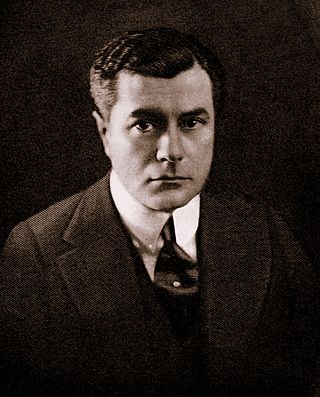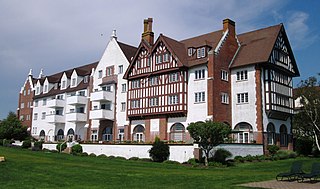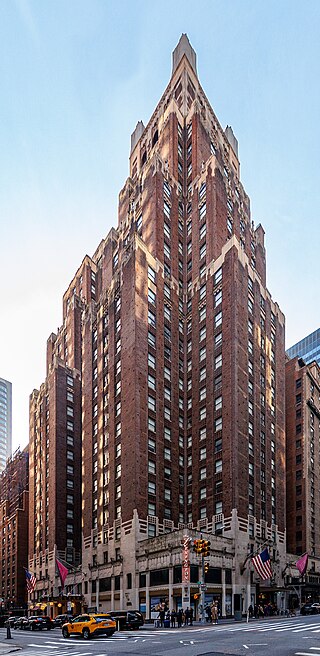
The Spanish Colonial Revival style is an architectural stylistic movement arising in the early 20th century based on the Spanish colonial architecture of the Spanish colonization of the Americas.

The Arizona Biltmore is a historic resort located in Phoenix near 24th Street and Camelback Road. Designed by Albert Chase McArthur, it opened on February 23, 1929, as part of the Biltmore Hotel chain. Actors Clark Gable and Carole Lombard often stayed there and the Tequila sunrise cocktail was invented there. It is part of LXR Hotels & Resorts.
Bowman-Biltmore Hotels was a hotel chain created by the hotel magnate John McEntee Bowman.

William Edmond Lescaze, was a Swiss-born American architect, city planner and industrial designer. He is ranked among the pioneers of modernism in American architecture.

The Biltmore Los Angeles is a historic hotel opened in 1923 and located opposite Pershing Square in Downtown Los Angeles, California. The hotel has 70,000 square feet (6,500 m2) of meeting and banquet space. Built with 1500 guestrooms, it now has 683.

The Miami Biltmore Hotel, commonly called TheBiltmore Hotel or The Biltmore, is a luxury hotel in Coral Gables, Florida. The hotel was designed by Schultze and Weaver and built in 1926 by John McEntee Bowman and George Merrick as part of the Biltmore hotel chain. The hotel's tower is inspired by the Giralda, the medieval tower of the cathedral of Seville.

Mediterranean Revival is an architectural style introduced in the United States, Canada, and certain other countries in the 19th century. It incorporated references from Spanish Renaissance, Spanish Colonial, Italian Renaissance, French Colonial, Beaux-Arts, Moorish architecture, and Venetian Gothic architecture.

Warren and Wetmore was an architecture firm based in New York City, a partnership established about 1889 by Whitney Warren (1864–1943) and Charles D. Wetmore (1866–1941). They had one of the most extensive practices of their time, and were especially known for having designed many large hotels.

Harder Hall is a historic former hotel building in Sebring, Florida. It is located on Lake Jackson, at 3300 Golfview Drive. It was regarded as one of the "Grande Dame hotels of Florida", until its closing in 1986. The hotel was designed by renowned Palm Beach architect William Manly King, and was considered the social center of Sebring. On June 20, 1990, it was added to the U.S. National Register of Historic Places.

John McEntee Bowman was a Canadian-born businessman, American hotelier and horseman, and the founding president of Bowman-Biltmore Hotels Corp.

Emmanuel Louis Masqueray (1861–1917) was a Franco-American preeminent figure in the history of American architecture, both as a gifted designer of landmark buildings and as an influential teacher of the profession of architecture dedicated to the principles of Beaux-Arts architecture.

The Atlanta Biltmore Hotel and Biltmore Apartments is a historic building located in Atlanta, Georgia. The complex, originally consisting of a hotel and apartments, was developed by William Candler, son of Coca-Cola executive Asa Candler, with Holland Ball Judkins and John McEntee Bowman. The original hotel building was converted to an office building in 1999. The building is currently owned by the Georgia Institute of Technology and is adjacent to Technology Square.

August Geiger was one of the most prominent American architects in South Florida from 1905 to the late 1940s. He experimented in Mission, Neo-Renaissance and Art Deco architecture, but is most noted for his works in the Mediterranean Revival style. A number of his works are listed on the U.S. National Register of Historic Places.
Meyer & Holler was an architecture firm based in Los Angeles, California, noted for its opulent commercial buildings and movie theatres, including Grauman's Chinese and Egyptian theatres, built during the 1920s. Meyer & Holler was also known as The Milwaukee Building Company.

Montauk Manor is a historic resort hotel located in the hamlet of Montauk in Suffolk County, New York, on Long Island. It was built in 1926 by Carl G. Fisher and is a four-story, 140 decorated condominium apartments in the Tudor Revival style. It was designed by Schultze and Weaver, the firm responsible for several Miami Beach-area hotels, The Breakers in Palm Beach, The Biltmore in Los Angeles, and The Pierre, The Sherry-Netherland and the former Waldorf-Astoria in Manhattan, New York City.

The Lexington Hotel, Autograph Collection is a hotel at 509 Lexington Avenue, at the southeast corner with 48th Street, in the Midtown Manhattan neighborhood of New York City. The 27-story hotel was designed by Schultze & Weaver in the Romanesque Revival style and contains 725 rooms. The Lexington, one of several large hotels developed around Grand Central Terminal as part of Terminal City, is a New York City designated landmark.

The Park Lane Hotel is a luxury hotel at 36 Central Park South, between Fifth and Sixth Avenues in Midtown Manhattan, New York City. Constructed in 1971, the hotel was designed by Emery Roth & Sons for real estate developer Harry Helmsley. The hotel operates under the ownership of Steve Witkoff's real estate investment firm, the Witkoff Group. A supertall skyscraper has been planned for the site, though that has been placed on hold.
Lester A. Cramer was an American architect. His most famous work was the Ecclesia, the Rosicrucian healing temple on Mount Ecclesia.

Alfred F. Schimek (1897-1980) was an architect active in Illinois and South Florida during the early and mid-20th century. He was responsible for notable projects in each region over the course of his career spanning five decades and is known primarily for his residential architecture work. His designs are associated mostly with updated interpretations of traditional European styles, such as Mediterranean Revival, though he also designed in the contemporary Bauhaus-influenced Modernist Art Deco style. Schimek also served in the board leadership of organizations in each region including the Illinois Society of Architects and the Greater Miami Civic Theater. As an inventor Schimek filed US patents for spring suspension systems and original door mounting designs.
















